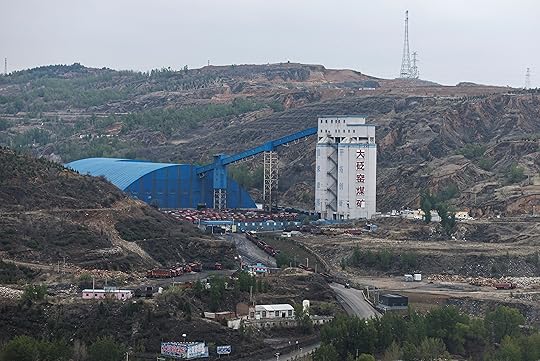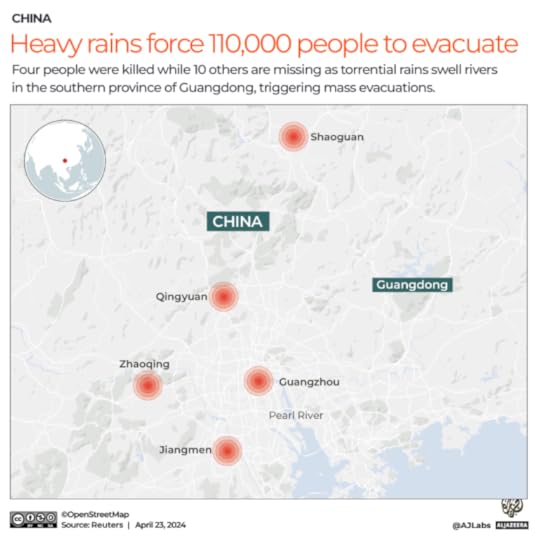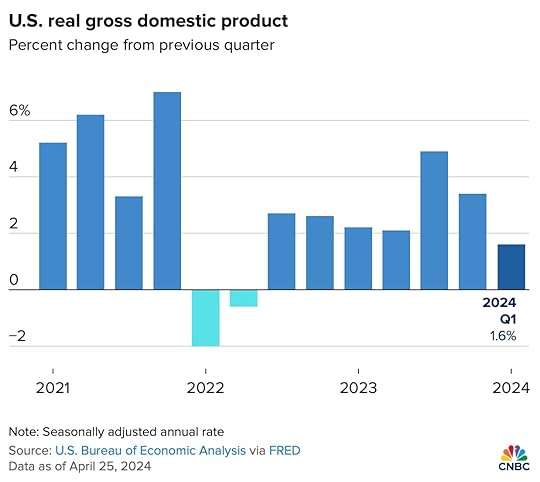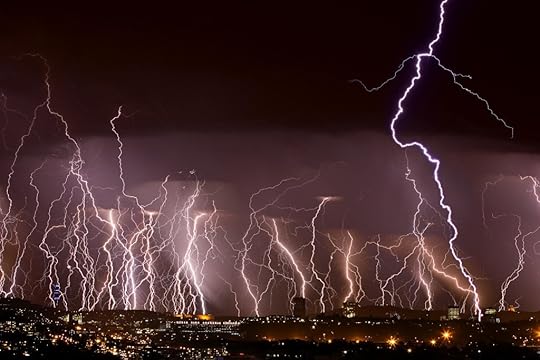Steve Bull's Blog, page 46
April 28, 2024
2023 Was Even Hotter Than Predicted, Raising Fears We’re in Uncharted Territory
 Sea surface temperature anomalies for 9 April 2024. (NASA’s Scientific Visualization Studio)
Sea surface temperature anomalies for 9 April 2024. (NASA’s Scientific Visualization Studio)Last year Earth warmed around 0.2 °C more than climate models predicted. While that may not seem like much in isolation, when you consider it’s a measure across an entire planet it amounts to a heck of a lot of unexplained heat.
“It’s humbling, and a bit worrying, to admit that no year has confounded climate scientists’ predictive capabilities more than 2023 has,” writes NASA climatologist Gavin Schmidt in an article for Nature.
“The 2023 temperature anomaly has come out of the blue, revealing an unprecedented knowledge gap perhaps for the first time since about 40 years ago, when satellite data began offering modellers an unparalleled, real-time view of Earth’s climate system.”
Schmidt warns if this unexplained anomaly doesn’t settle by August, in line with previous El Niño fluctuations, then we will be in uncharted territory.
Several theories have been posed for the excess heat beyond what is expected from the El Niño and known rates of increasing CO2. These include a decrease in surface-cooling aerosols from shipping after regulation changes in 2020; an increase in heat-trapping water vapor from the 2022 eruption of Hunga Tonga-Hunga Ha’apai; and peak activity in the current solar cycle sending more heat our way.
But even combined these all don’t fully account for observed extra heat, Schmidt argues.
The concern is we’re missing something critical in our understanding of Earth’s climate systems, that would explain an accelerated rate of warming, such as a potential miscalibration in the start date of humanity’s impact on the climate.
Being ahead of schedule would explain why extreme climate consequences, including deadly floods, fires, and storms, have been whacking us so hard and fast already.
…click on the above link to read the rest of the article…
It’s All Chemistry, Isn’t It?
This is #29 in a series of month-end reflections on the state of the world, and other things that come to mind, as I walk, hike, and explore in my local community.

Chart above is my own invention, having studied the various chemicals that scientists believe are involved in feelings of intense love.
The title of this post is a quote attributed to Jimi Hendrix, when he was asked in an interview to explain the special chemistry he had with his audiences.
It’s impossible not to look at them. They are possessed, so utterly consumed by the flood of chemicals feeding off each other that they are oblivious to everyone else in the café. Their feral passion for each other is at once riveting and disconcerting. A man noticing their antics looks disapprovingly. A woman looks at them with a torn expression, a mixture of what might be dismay and (perhaps nostalgic) envy…
… But I’m getting way ahead of myself. Back to this couple in a moment.
This body has taken me for a walk, today, to the nearby lake. It’s a rare sunny spring day here on the temperate rainforest coast, and there are lots of people about.
Recently I’ve been reading a lot about bonobos and chimps, our cousins from which we separated evolutionarily about six million years ago, and with whom we still share almost 99% of our DNA. As Robert Sapolsky discovered with his suddenly-matriarchal and peaceful baboon troupe, the rather extraordinary differences in behaviour between chimps and bonobos in the wild (most people can’t tell them apart) are not biologically, but culturally conditioned. Chimps and gorillas evolved on the north side of the Congo river; bonobos on the south side. The river was too wide for the species to cross…
…click on the above link to read the rest of the article…
China can’t quit coal by 2040, researchers say, despite global climate goals
 A general view of a coal mine during a Huawei-organised media tour, in Yulin city, Shaanxi province, China April 24, 2023. REUTERS/Tingshu Wang Purchase Licensing Rights, opens new tabBEIJING, April 23 (Reuters) – China’s coal consumption will fall by just one-third by 2040, according to a report by a European consultancy published on Tuesday, threatening climate targets that call for phasing out much of global coal use by 2040.The International Energy Agency has said that global coal power capacity has to be eliminated by 2040 to keep average global temperature rises within the key threshold of 1.5 degrees Celsius (2.7 degrees Fahrenheit).However, Norwegian risk assessment firm DNV said in its report that its findings indicate China’s coal consumption – the world’s biggest – will see a “minor uptick” in the next two years and then fall by one-third by 2040, ending up at around 25% of its peak in 2050.The findings underscore China’s outlook on fossil fuels. In September, former climate envoy Xie Zhenhua told the COP28 climate talks that it would be “unrealistic to completely phase out fossil fuel energy”.China will continue using coal despite a massive ramp-up in renewable generation, which will make up 88% of China’s power generation mix in 2050, the report predicts.China approved another 114GW of coal power plants last year, up 10% from 2022, and the iron and steel sectors are on track to overtake power as the biggest consumers of coal by mid-century. Coal-to-chemicals will also make up a significant share of the remaining demand, according to the report.Decarbonisation of the steel sector through new methods such as cleaner electric arc furnace technology is lagging in China, research has shown.Natural gas consumption will stay part of the energy mix with consumption falling only 2% from 2022 levels by 2050, the report said.…click on the above link to read the rest of the article…
A general view of a coal mine during a Huawei-organised media tour, in Yulin city, Shaanxi province, China April 24, 2023. REUTERS/Tingshu Wang Purchase Licensing Rights, opens new tabBEIJING, April 23 (Reuters) – China’s coal consumption will fall by just one-third by 2040, according to a report by a European consultancy published on Tuesday, threatening climate targets that call for phasing out much of global coal use by 2040.The International Energy Agency has said that global coal power capacity has to be eliminated by 2040 to keep average global temperature rises within the key threshold of 1.5 degrees Celsius (2.7 degrees Fahrenheit).However, Norwegian risk assessment firm DNV said in its report that its findings indicate China’s coal consumption – the world’s biggest – will see a “minor uptick” in the next two years and then fall by one-third by 2040, ending up at around 25% of its peak in 2050.The findings underscore China’s outlook on fossil fuels. In September, former climate envoy Xie Zhenhua told the COP28 climate talks that it would be “unrealistic to completely phase out fossil fuel energy”.China will continue using coal despite a massive ramp-up in renewable generation, which will make up 88% of China’s power generation mix in 2050, the report predicts.China approved another 114GW of coal power plants last year, up 10% from 2022, and the iron and steel sectors are on track to overtake power as the biggest consumers of coal by mid-century. Coal-to-chemicals will also make up a significant share of the remaining demand, according to the report.Decarbonisation of the steel sector through new methods such as cleaner electric arc furnace technology is lagging in China, research has shown.Natural gas consumption will stay part of the energy mix with consumption falling only 2% from 2022 levels by 2050, the report said.…click on the above link to read the rest of the article…
China evacuates over 100,000 as heavy rain continues to lash south
China is facing increasingly extreme weather events as climate change takes its toll.
China has evacuated more than 100,000 people as heavy rain continues to lash the southern province of Guangdong.
Authorities raised the highest level of alarm on Tuesday as the storms showed no sign of letting up. Flooding has already killed four people, with another 10 reported missing, in just the latest episode of extreme weather to hit China as climate change affects the country.
Torrential rains have been swelling rivers in Guangdong, prompting state media to warn of the risk of floods at a level “seen around once a century”.
 (Al Jazeera)
(Al Jazeera)Footage from across Guangdong showed flooded villages, farmland and cities, along with collapsed bridges and floating vehicles. In addition to the 110,000 people who have been evacuated, at least 25,000 are in emergency shelters.
In the provincial capital, Guangzhou, authorities have registered cumulative rainfall of 609mm in April so far, which is already the highest monthly volume since record-keeping began in 1959.
The sustained torrent has hit the Pearl River Delta region, a manufacturing hub and one of the country’s most populated regions, for close to a week.
Home to some 127 million people, the region usually sees heavy rains in about September. It has been experiencing more intense and more frequent rainstorms and floods in recent years.
“Please quickly take precautions and stay away from dangerous areas such as low-lying areas prone to flooding,” authorities in the coastal city of Shenzhen – China’s third largest – said as the red alert was issued.
“Pay attention to heavy rains and resulting disasters such as water logging, flash floods, landslides, mudslides, and ground caving in,” they warned.
Can the US Legally Seize Russian Assets? Should It?
Congress’s aid package encourages the president to seize frozen Russian reserves to support Ukraine. But the legality and desirability are both questionable.

REPO Act Lets Biden Boost Ukraine
The Wall Street Journal writer, Robert B. Zoellick, says REPO Act Lets Biden Boost Ukraine
Now that Congress has approved assistance for Ukraine, the Biden administration should forge a long-term economic and military plan that will sustain that country in its war of attrition.
If the U.S. continues to dribble out support, it would be making a huge mistake. American public support is likely to wane, and the Europeans are absorbed with internal debates. The nature of the war has changed—militarily, technologically and economically—over more than two years. President Biden’s reactive approach reflects his senatorial style: He waits for events, issues statements and fails to seize the initiative. Congress is giving him one last chance to be a wartime leader.
The aid package’s hidden gem is the Rebuilding Economic Prosperity and Opportunity for Ukrainians Act, or REPO. It encourages Mr. Biden to transfer frozen Russian reserves to a trust fund for Ukraine. Members of Congress from both parties recognize that taxpayers want Mr. Biden to use an estimated $300 billion of Russian money to sustain Ukraine economically before asking Americans to pay more. The administration has hesitated to take this step but must do so now.
Last year Treasury Secretary Janet Yellen justified inaction by raising concerns about how such transfers might affect the value of the dollar and the euro. But two years after freezing the Russian reserves, the dollar is stronger and the euro is fine—in part because the alternatives are poor. China’s yuan isn’t a trustworthy reserve asset. The world would be safer if countries realized that their foreign reserves would be imperiled if they invade the neighbors.
…click on the above link to read the rest of the article…
Economy Plunges into Stagflation with Both Feet
Talk about a one-two-three punch to the ground!

Stagflation came in perfectly on target for The Daily Doom’s predictions today. Real GDP is now falling much harder than was expected yesterday by two-faced Jamie Dimon when he spoke out of his second face, saying the economy is “booming,” backed by “healthy consumer finances.” He called it an “unbelievable” economy. I’ll agree with that part. I certainly didn’t believe it when he said it yesterday.
You see, only the day before, his first face said the economy looked like we could be heading into the stagflation of the 70s, which means a stagnant economy with high inflation. Those are diametrically opposite claims to my way of thinking. After he appeared to walk stagflation back yesterday when he said the economy was booming, today we all learned we are already in the stagflation of the 70s. (We’ve actually been in it all year, but it finally got reported.)
The official report on Q1 real GDP for 2024 showed the economy is stagnant, while the Personal Consumption Expenditures (PCE) price index scored its largest inflation gain all year (at 3.4% annualized). To be specific, GDP fell off to a 1.6% annualized pace (adjusted for seasonality and inflation), according to the Bureau of Economic Analysis. That is a plunge to less than half of the 3.4% growth the BEA claimed for the final quarter of 2023 and the 4.9% in the quarter before that, and it even came in well below the 2.4% that was forecast recently by economists in a Dow Jones survey.
So, the two-faced Dimon should have stayed with what his first face said two days ago because GDP readings under 2% are usually considered borderline recession—far from “BOOMING,” which means the US economy is, in fact, stagnant with rising inflation, which means the 1970s are back … because …

…click on the above link to read the rest of the article…
Science Snippets: Planting Trees in Some Locations Warms Earth
Draft script:
A paper in Phys.Org published 31 March 2024 is titled Planting trees in wrong places heats the planet: Study. The study referenced in the title appeared in Nature Communications on 26 March 2024. It was produced by 11 scholars.
One of the study’s co-authors was quoted in the Phys.Org article: “There are some places where putting trees back leads to net climate negative outcomes.” In fact, the peer-reviewed paper indicates that reforestation projects that failed to include albedo in the analysis overestimated the benefit to the climate by 20 to 80%.
Hot, humid environments such as the Amazon Basin and central Africa store abundant carbon with little change to albedo. These are ideal places for reforestation. On the other hand, temperate grasslands and savannas sequester and store relatively little carbon and can negatively alter albedo. As a result, promises of enhanced carbon capture tend to be overblown in these areas.
The co-author quoted above indicated in the Phys.Org article that even projects in the best locations were probably delivering 20% less cooling than estimated when albedo changes are included in the analysis. Although there are good reasons beyond carbon sequestration to plant trees, it is important to focus reforestation efforts in proper locations. Given the limited money available for reforestation projects throughout the world, the Phys.Org article and the peer-reviewed paper indicate the importance of prioritizing projects.
The peer-reviewed, open-access paper in Nature Communications is titled Accounting for albedo change to identify climate-positive tree cover restoration. It was published 6 March 2024. I’ll read the entire Abstract: “Restoring tree cover changes albedo, which is the fraction of sunlight reflected from the Earth’s surface. In most locations, these changes in albedo offset or even negate the carbon removal benefits with the latter leading to global warming…
…click on the above link to read the rest of the article…
April 27, 2024
Central Banks Are Wrong about Rate Cuts

When we talk about monetary policy, people do not understand the importance of interest rates reflecting the reality of inflation and risk. Interest rates are the price of risk and manipulating them down leads to bubbles that end in financial crises, while imposing too high rates can penalize the economy. Ideally, interest rates would flow freely and there would be no central bank to fix them.
A price signal as important as interest rates or the amount of money would prevent the creation of bubbles and, above all, the disproportionate accumulation of risk. The risk of fixing rates too high does not exist when central banks impose reference rates, as they will always make it easier for state borrowing—artificial currency creation—in the most convenient—what they call “no distortions”—and cheap way.
Many analysts say that central banks do not impose interest rates; they only reflect what the market demands. Surprisingly, if that were the case, we wouldn’t have financial traders stuck to screens on a Thursday waiting to decipher what the rate decision is going to be. Moreover, if the central bank only responds to market demand, it is a good reason to let interest rates float freely.
Citizens perceive that raising interest rates with high inflation is harmful; however, they do not seem to understand that what was really destructive was having negative real and nominal interest rates. That’s what encourages economic agents to take far more risks than we can take and to disguise excess debt with a false sense of security. At the same time, it is surprising that citizens praise low rates but then complain that home prices and risky assets rise too fast.
…click on the above link to read the rest of the article…
Accelerating Climage Change and Rising Global Conflict

THE STORM IS RISING
As the sun sets on another day in what could be called the Anthropocene epoch, we stand at the precipice, watching as the once-stable climate system of our planet lurches toward a cascade of ecological tipping points, accelerating “faster than expected.” Recent phenomena, such as the atmospheric rivers causing unprecedented flooding in California, are not isolated incidents. Rather, they are harbingers of a more chaotic climate regime. This is the reality of our world—a world where climate change is not a distant threat but an immediate crisis.
The accelerating pace of climate change and its increasingly visible impacts, from the devastating wildfires in Australia and the Amazon to the melting ice caps in Greenland and Antarctica, underscores a grim truth. That we are entering uncharted territories, and ecological tipping points are being crossed with alarming frequency. These are not mere fluctuations in weather patterns but stark indicators of a planet in distress, signaling the onset of irreversible damage to the very fabric of Earth’s ecosystems.
Chaotic weather patterns do not even have to be very destructive to have catastrophic consequences. The loss of stability and predictability when it comes to weather conditions can have a disastrous effect on global food production. Agriculture requires a stable pattern in the weather, and that is something we are losing rapidly.
The storm is here, and it is one of our own making.

The root cause of this acceleration? A global society stubbornly tethered to fossil fuels, despite the overwhelming evidence of their role in driving climate change. The fossil fuel industry, with its insatiable thirst for profit, has become the architect of our demise, actively obstructing efforts to transition to renewable energy sources…
…click on the above link to read the rest of the article…
The Day We Stopped Trusting Media
Imagine future election campaigns
One of the first posts in this newsletter’s Shrinking Trust Horizon series was about how “deep fake” technology will make fake images, videos, and audio recordings almost indistinguishable from the real thing. This will kill millions of modeling and acting jobs, while weaponizing audio and video in all kinds of disturbing ways.
That day has apparently arrived:
Baltimore high school teacher arrested over deepfake audio of principalA Maryland high school teacher has been arrested for allegedly using AI to deepfake a bogus recording of his principal making racist comments.
Dazhon Darien, 31, is accused of creating the hoax audio of Pikesville High School Principal Eric Eiswert.
Mr Eiswert was placed on leave and had police outside his home amid death threats he received over the fake clip.
Mr Darien was held at an airport after a security check over a gun in his bag found an arrest warrant against him.
He faces charges of stalking, theft, disruption of school operations and retaliation against a witness.
Baltimore County Schools Superintendent Myriam Rogers said the school, as well as the Baltimore County Police Department, launched an investigation on 17 January when they were made aware of the voice recording.
Detectives requested a forensic analysis of the audio, which found it was not authentic.
In the recording, Mr Eiswert’s deepfaked voice is heard making disparaging comments about black students’ test scores, black teachers and Jews.
Police believe Mr Darien, the Baltimore-area school’s athletic director, made the recording to retaliate against Mr Eiswert because he was pursuing an investigation into potential mishandling of district funds.
Mr Darien had authorised a payment of nearly $2,000 (£1,600) to his roommate, falsely claiming the roommate was an assistant coach for the Pikesville girls’ soccer team, reports the Baltimore Sun newspaper.
…click on the above link to read the rest of the article…



